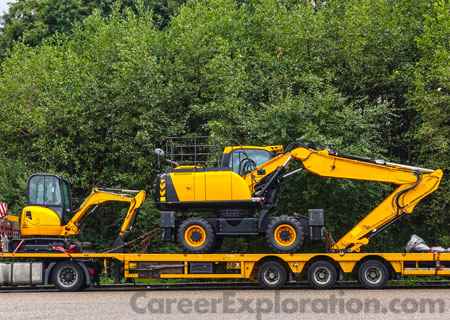
Construction Equipment Operator
Summary
Construction equipment operators drive, maneuver, or control the heavy machinery used to construct roads, buildings and other structures.
What they do
Construction equipment operators typically do the following:
- Clean and maintain equipment, making basic repairs as necessary
- Report malfunctioning equipment to supervisors
- Move levers, push pedals, or turn valves to control equipment
- Drive and maneuver equipment
- Coordinate machine actions with crew members using hand or audio signals
- Follow safety standards
Construction equipment operators use machinery to move construction materials, earth, and other heavy materials at construction sites and mines. They operate equipment that clears and grades land to prepare it for the construction of roads, bridges, and buildings, as well as runways, power generation facilities, dams, levees, and other structures.
Work Environment
Construction equipment operators work in nearly every weather condition, although rain or extremely cold weather can stop some types of construction. Workers often get dirty, greasy, muddy, or dusty. Some operators work in remote locations on large construction projects, such as highways and dams, or in factories or mines.
How to become a Construction Equipment Operator
Many workers learn equipment operation on the job after earning a high school diploma or equivalent, while others learn through an apprenticeship or by attending vocational schools.
A high school diploma or equivalent is required for most jobs. Vocational training and math courses are useful, and a course in auto mechanics can be helpful because workers often perform maintenance on their equipment.
Learning at vocational schools may be beneficial in finding a job. Schools may specialize in a particular brand or type of construction equipment.
Some schools incorporate sophisticated simulator training into their courses, allowing beginners to familiarize themselves with the equipment in a virtual environment before operating real machines.
Many workers learn their jobs by operating light equipment under the guidance of an experienced operator. Later, they may operate heavier equipment, such as bulldozers. Some construction equipment with computerized controls requires greater skill to operate. Operators of such equipment may need more training and some understanding of electronics.
Pay
The median annual wage for construction equipment operators was $48,160 in May 2019. The median wage is the wage at which half the workers in an occupation earned more than that amount and half earned less. The lowest 10 percent earned less than $31,780, and the highest 10 percent earned more than $84,650.
Job Outlook
Overall employment of construction equipment operators is projected to grow 4 percent from 2019 to 2029, about as fast as the average for all occupations. Employment growth is expected to vary across the construction equipment operator occupations.
Similar Job Titles
Back Hoe Operator, Engineering Equipment Operator, Equipment Operator (EO), Forklift Operator, Heavy Equipment Operator, Hot Mix Asphalt Operator, Machine Operator, Motor Grader Operator, Operating Engineer, Track Hoe Operator, Concrete Paving Machine Operator,
Related Occupations
Paving, Surfacing and Tamping Equipment Operator; Pile-Driver Operator; Highway Maintenance Worker; Crane and Tower Operator; Excavating and Loading Machine and Dragline Operator
More Information
The trade associations listed below represent organizations made up of people (members) who work and promote advancement in the field. Members are very interested in telling others about their work and about careers in those areas. As well, trade associations provide opportunities for organizational networking and learning more about the field’s trends and directions.
- American Subcontractors Association - The ASA promotes the rights and interests of subcontractors, specialty contractors and suppliers by building strength in community through education, advocacy, networking and professional growth. Members have access to a plethora of on-demand videos, manuals, technical papers, and more.
- Associated Builders and Contractors - ABC's membership represents all specialties within the U.S. construction industry and is comprised primarily of firms that perform work in the industrial and commercial sectors. Students and those wishing a career in construction will find an abundance of education and craft training information and resources.
- International Brotherhood of Electrical Workers - This organization represents 775,000 active members and retirees who work in a wide variety of fields, including utilities, construction, telecommunications, broadcasting, manufacturing, railroads and government.
- Laborers' International Union of North America - LIUNA members are a skilled and experienced union workforce trained to work safely in the construction and energy industries. Members also work in every area of the energy sector, helping to build solar plants, wind farms, and natural gas and oil pipelines, as well as, being skilled in the maintenance of nuclear and coal power plant facilities. Click here to review this organization’s training and education
- National Center for Construction Education and Research - The mission of this organization is simple, to build a safe, productive and sustainable workforce of craft professionals. For those in-training or learning in the field, NCCEAR has competency-based curricula with measurable objectives.
- The Associated General Contractors of America - This association is far reaching with over 27,000 firms, including more than 7,000 of America’s leading general contractors, nearly 9,000 specialty-contracting firms and almost 11,000 service providers and suppliers belong to the association through its nationwide network of chapters. A number of educational programs designed to enhance career development opportunities for individuals and improve the performance of construction companies and the industry are offered. As well, 170 student chapters across the country provide young professionals with an opportunity to observe and develop their skills with current industry leaders.
Magazines and Publications
Content retrieved from: US Bureau of Labor Statistics-OOH www.bls.gov/ooh,
CareerOneStop www.careeronestop.org, O*Net Online www.onetonline.org
